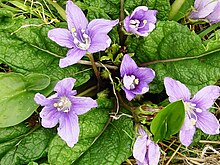
Back Alraune (Kulturgeschichte) ALS Alraun Azerbaijani Alraune (Kulturgeschichte) German Alraunijuur Estonian ماندراک - مهر گیاه Persian Alrauna Polish Альраун Russian



A mandrake is the root of a plant, historically derived either from plants of the genus Mandragora (in the family Solanaceae) found in the Mediterranean region, or from other species, such as Bryonia alba (the English mandrake, in the family Cucurbitaceae) or the American mandrake (Podophyllum peltatum in the family Berberidaceae) which have similar properties. The plants from which the root is obtained are also called "mandrakes". Mediterranean mandrakes are perennial herbaceous plants with ovate leaves arranged in a rosette, a thick upright root, often branched, and bell-shaped flowers that produce yellow or orange berries. They have been placed in different species by different authors. They are highly variable perennial herbaceous plants with long thick roots (often branched) and almost no stem. The leaves are borne in a basal rosette, and are variable in size and shape, with a maximum length of 45 cm (18 in). They are usually either elliptical in shape or wider towards the end (obovate), with varying degrees of hairiness.[2]
Because mandrakes contain deliriant hallucinogenic tropane alkaloids and the shape of their roots often resembles human figures, they have been associated with magic rituals throughout history, including present-day contemporary pagan traditions.[3]
- ^ Wolfthal (2016) Fig. 8-10
- ^ Cite error: The named reference
Ungr98was invoked but never defined (see the help page). - ^ John Gerard (1597). "Herball, Generall Historie of Plants". Claude Moore Health Sciences Library. Archived from the original on 2012-09-01. Retrieved 2015-08-03.